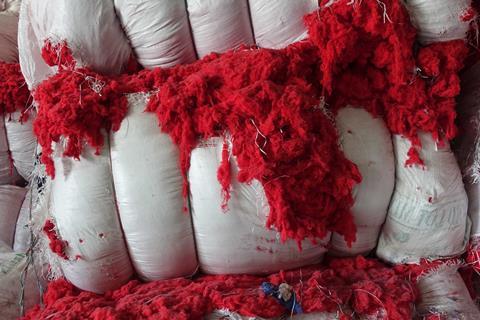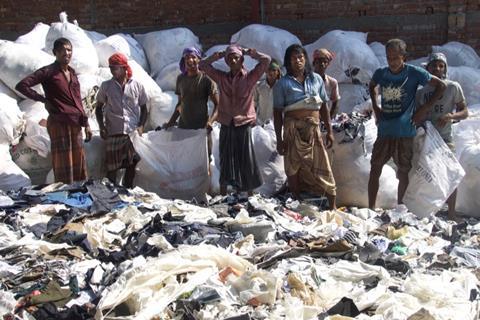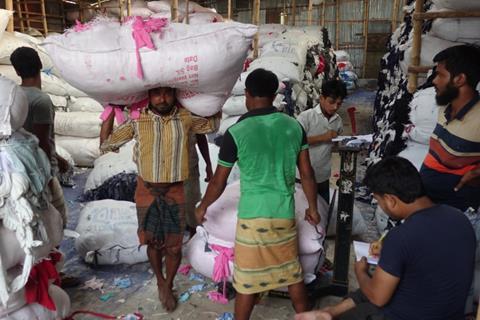It’s no secret that waste represents a huge problem in the apparel industry, but what is less understood is the potential untapped resource such waste represents. SaaS technologies are looking to digitize, connect, and scale global textile-to-textile recycling; connecting fashion brands and manufacturers with waste handlers and recyclers, and build the infrastructure to scale circular supply chains. We spoke with Raffaella Carluccio of Reverse Resources, to understand the goals and challenges that characterize the tracking and processing of textile waste.

In its white paper The Undiscovered Business Potential of Production Leftovers within Global Fashion Supply Chains, Reverse Resources states that in Bangladesh alone, by-products represent 25% of the total yarn consumption of garment production. Furthermore: “Volumes of production leftovers are systematically underreported and thus underestimated by brands and researchers,” particularly in factories located in “developing countries.”
Textile waste is an untapped resource
There are several ways to look at this waste. The first — and now outdated way — is to see it as a necessary side-effect of production, growth, and meeting consumer needs. The second is to see the physical mounds of discarded material as a sign that something needs to change, in particular with regard to recycling. And the third, more progressive and conducive to circularity, is to see this as an untapped resource from which the fashion industry could gain much higher economic value if it took a more holistic approach to material circulation throughout global supply chains. This is the approach of Reverse Resources.
Raffaella Carluccio, project coordinator at Reverse Resources (RR) outlines this potential: “Post-industrial waste streams represent a significant opportunity for those brands who are beginning to consider waste as a resource, redirecting it to emerging/scaling recycling technologies.” She points to the positive increase in sorting technologies entering the market. And, of course, “The intrinsic value of the recycled pellet/fibers and the acquired independence from virgin materials represent significant potential for the whole EU industry.”
However, Carluccio adds: “One of the main challenges to recycling post-consumer waste is the scarcity of technologies to tackle complex material blends. Moreover, the time and resources needed for existing textile recycling technologies — to expedite their commercial scaling — and the readiness of the market itself to consider textile waste as a resource still hinder the development of circular supply chains.”

SaaS has the potential to track and manage textile waste
To date, RR has mapped waste across 20 countries for fashion brands and organizations such as the United Nations Industrial Development Organization, Global Fashion Agenda, Accelerating Circularity, and Fashion for Good. The first step is to identify exactly when and how much waste is being produced and at what stage. “Currently, global brands do not have the tools available to map and trace their waste along their complex supply chains, which makes it difficult to steer and make textile waste available for recyclers,” says Carluccio.
SaaS technologies are one solution to digitize, connect, and scale global textile-to-textile recycling. By digitizing data and connecting brands and manufacturers with waste handlers and recyclers, solution providers aim to build the infrastructure to scale circular supply chains. Reverse Resources offers a SaaS platform that digitizes data on textile waste flows. “Starting with the brands, RR’s services and digital tools allow them to understand how much and what types of waste they are creating across the value chain. This tracing and then matchmaking of textile waste streams to appropriate types of recycling technologies enables brands to valorize their waste and measure their circularity progress.”
For example, large brands’ production in manufacturing countries is often characterized by large volumes of similar products, generating fairly standardized waste. This presents an untapped opportunity to valorize and recycle or remanufacture (where larger portions of material are reused as fabrics, products or product details) large volumes of post-industrial textile waste.
But even this seemingly simple step is not without problems: “These enormous volumes of textile leftovers, cutting scraps, and the mixed waste produced daily, cannot lay around the factory warehouses for long.” It is at this point, Carluccio explains, “the role of local waste handling companies (i.e. collectors, sorters, and pre-processors) who provide services such as logistics, material aggregation, storage, cleaning, quality checking, and segregation, to mention but a few, become essential.”
Information is key
In order to harness the potential of waste as a resource, large networks of stakeholders need accurate, up-to-date information; a digital mapping service The data gathered via the RR platform generates real-time aggregated data and insights into waste material flows. These are instrumental for the industry to get a bird’s-eye view of their supply chains and make relevant and informed decisions accordingly.
Recyclers can access the highest quality textile waste materials in the most affordable and efficient manner, and RR’s technology meets recyclers’ needs for predictable, traceable, and compliant waste supply chains.
The dispersed nature of post-consumer waste supply chains presents another problem, increasing the costs of collection, sorting, and pre-processing activities. As such, the costs are often higher than the target price recycling companies are willing to pay.

In its white paper, Reverse Resources explains: “Leftover fabrics usually move through 3-5 levels of different traders before reaching next production. An extensive number of intermediaries distorts the market in several ways. It brings up the market prices, lowers lead times for recycled materials, holds back the spread of knowledge on best practices and limits the percentage of leftovers reaching optimum new life cycles.” To maximize the potential of waste as a business opportunity, the loops of the supply chain have to be shortened.
For Carluccio, the solution is not to eliminate the role of waste handlers in the textile waste management landscape. On the contrary, part of the objectives of such platforms is to include, formalize, and digitize waste management entities so that traceability and social compliance can be implemented. It’s about streamlining the process to reduce costs. “The entire potential of textile-to-textile recycling can only be achieved if the waste management entities also participate in the value-creation process. By providing alternatives for current use cases and urging them to evolve to a service provider role, waste handlers can also benefit from market formalization.”
Social compliance remains a challenge
This brings with it another consideration: Whereas social compliance in garment factories has improved significantly over recent years, the waste-handling supply chain has so far been the invisible part of global circular supply chains. “Generally speaking, small, local, and informal entity waste handlers have poorer social compliance standards. High-value recyclers must comply with the standards of the global brands they supply. As such, the lack of compliance within the waste handling industry represents a common problem across all recycling companies, which is another hindrance to investments in circular economy systems.”
Difficulties when dealing with waste are not unique to the textile industry. Waste management within any industry may flow into informal networks — often characterized by different levels of corruption, unregulated practices, and misconduct. Within this context, European and Western countries are no exceptions.

As such, Carluccio points out, “The informality of the waste supply chain represents a common challenge for companies, industries, and systems adopting the circular economy paradigm. Digital traceability and transparency technologies provide a solution, which sheds light on waste supply chains and ensures the liability of the stakeholders.” Additionally, SaaS technologies like RR’s provide opportunities, for example, for third-party verification of surplus supply chains; reducing opportunities for greenwashing and providing reliable data for brands committed to embedding circularity in their processes.
But ultimately, for Carluccio, even with developing technologies and platforms, to overcome the obstacles posed by the current fiscal structure, policy interventions are required to kick-start a functional and viable post-consumer recycling system.





